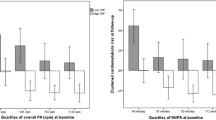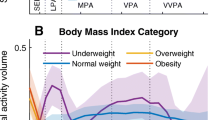Abstract
Clustering of cardiometabolic risk factors can occur during childhood and predisposes individuals to cardiometabolic disease. This study calculated clustered cardiometabolic risk in 100 children and adolescents aged 10–14 years (59 girls) and explored differences according to cardiorespiratory fitness (CRF) levels and time spent at different physical activity (PA) intensities. CRF was determined using a maximal cycle ergometer test, and PA was assessed using accelerometry. A cardiometabolic risk score was computed as the sum of the standardised scores for waist circumference, blood pressure, total cholesterol/high-density lipoprotein ratio, triglycerides and glucose. Differences in clustered cardiometabolic risk between fit and unfit participants, according to previously proposed health-related threshold values, and between tertiles for PA subcomponents were assessed using ANCOVA. Clustered risk was significantly lower (p < 0.001) in the fit group (mean 1.21 ± 3.42) compared to the unfit group (mean −0.74 ± 2.22), while no differences existed between tertiles for any subcomponent of PA. Conclusion These findings suggest that CRF may have an important cardioprotective role in children and adolescents and highlights the importance of promoting CRF in youth.

Similar content being viewed by others
References
Abbasi F, Brown BW Jr, Lamendola C, McLaughlin T, Reaven GM (2002) Relationship between obesity, insulin resistance, and coronary heart disease risk. J Am Coll Cardiol 40(5):937–943
Aires L, Silva P, Silva G, Santos MP, Ribeiro JC, Mota J (2010) Intensity of physical activity, cardiorespiratory fitness, and body mass index in youth. J Phys Act Health 7(1):54–59
Anderssen SA, Cooper AR, Riddoch C, Sardinha LB, Harro M, Brage S et al (2007) Low cardiorespiratory fitness is a strong predictor for clustering of cardiovascular disease risk factors in children independent of country, age and sex. Eur Society Cardio 14(4):526–531
Baquet G, Stratton G, Van Praagh E, Berthoin S (2007) Improving physical activity assessment in prepubertal children with high-frequency accelerometry monitoring: a methodological issue. Prev Med 44(2):143–147
Berenson GS, Srinivasan SR, Bao W, Newman WP 3rd, Tracy RE, Wattigney WA (1998) Association between multiple cardiovascular risk factors and atherosclerosis in children and young adults. The Bogalusa Heart Study. N Engl J Med 338(23):1650–1656
Blair SN, Cheng Y, Holder JS (2001) Is physical activity or physical fitness more important in defining health benefits? Med Sci Sports Exerc 33(Suppl 6):S379–S399
Boddy LM, Hackett AF, Stratton G (2010) Changes in fitness, body mass index and obesity in 9–10 year olds. J Hum Nutr Diet 23(3):254–259
Boreham C, Twisk J, Murray L, Savage M, Strain JJ, Cran G (2001) Fitness, fatness, and coronary heart disease risk in adolescents: the Northern Ireland Young Hearts Project. Med Sci Sports Exerc 33(2):270–274
Bouchard C, Rankinen T (2001) Individual differences in response to regular physical activity. Med Sci Sports Exerc 33(6 Suppl):S446–S451
Brage S, Wedderkopp N, Ekelund U, Franks PW, Wareham NJ, Andersen LB et al (2004) Features of the metabolic syndrome are associated with objectively measured physical activity and fitness in Danish children: the European Youth Heart Study (EYHS). Diabetes Care 27(9):2141–2148
Camhi SM, Katzmarzyk PT (2010) Tracking of cardiometabolic risk factor clustering from childhood to adulthood. Int J Pediatr Obes 5(2):122–129
Chen W, Srinivasan SR, Elkasabany A, Berenson GS (1999) Cardiovascular risk factors clustering features of insulin resistance syndrome (Syndrome X) in a biracial (Black-White) population of children, adolescents, and young adults: the Bogalusa Heart Study. Am J Epidemiol 150(7):667–674
Cole TJ, Freeman JV, Preece MA (1995) Body mass index reference curves for the UK, 1990. Arch Dis Child 73(1):25–29
Department of Health (2011) Start active, stay active: a report on physical activity for health from the four home countries’ Chief Medical Officers. http://www.dh.gov.uk/prod_consum_dh/groups/dh_digitalassets/documents/digitalasset/dh_128210.pdf. Accessed 14 Jul 2011
Ekelund U, Anderssen SA, Froberg K, Sardinha LB, Andersen LB, Brage S (2007) Independent associations of physical activity and cardiorespiratory fitness with metabolic risk factors in children: the European Youth Heart Study. Diabetologia 50(9):1832–1840
Ekelund U, Sardinha LB, Anderssen SA, Harro M, Franks PW, Brage S et al (2004) Associations between objectively assessed physical activity and indicators of body fatness in 9- to 10-y-old European children: a population-based study from 4 distinct regions in Europe (the European Youth Heart Study). Am J Clin Nutr 80(3):584–590
Fairclough SJ, Boddy LM, Hackett AF, Stratton G (2009) Associations between children’s socioeconomic status, weight status, and sex, with screen-based sedentary behaviours and sport participation. Int J Pediatr Obes 4(4):299–305
Freeman JV, Cole TJ, Chinn S, Jones PR, White EM, Preece MA (1995) Cross sectional stature and weight reference curves for the UK, 1990. Arch Dis Child 73(1):17–24
Gami AS, Witt BJ, Howard DE, Erwin PJ, Gami LA, Somers VK et al (2007) Metabolic syndrome and risk of incident cardiovascular events and death: a systematic review and meta-analysis of longitudinal studies. J Am Coll Cardiol 49(4):403–414
Golden SH, Folsom AR, Coresh J, Sharrett AR, Szklo M, Brancati F (2002) Risk factor groupings related to insulin resistance and their synergistic effects on subclinical atherosclerosis: the atherosclerosis risk in communities study. Diabetes 51(10):3069–3076
Graham I, Atar D, Borch-Johnsen K, Boysen G, Burell G, Cifkova R et al (2007) European guidelines on cardiovascular disease prevention in clinical practice: executive summary: Fourth Joint Task Force of the European Society of Cardiology and Other Societies on Cardiovascular Disease Prevention in Clinical Practice. Eur Heart J 28(19):2375–2414
Gutin B, Barbeau P, Owens S, Lemmon CR, Bauman M, Allison J et al (2002) Effects of exercise intensity on cardiovascular fitness, total body composition, and visceral adiposity of obese adolescents. Am J Clin Nutr 75(5):818–826
Gutin B, Yin Z, Humphries MC, Barbeau P (2005) Relations of moderate and vigorous physical activity to fitness and fatness in adolescents. Am J Clin Nutr 81(4):746–750
Hannon TS, Janosky J, Arslanian SA (2006) Longitudinal study of physiologic insulin resistance and metabolic changes of puberty. Pediatr Res 60(6):759–763
Hawley JA (2002) Adaptations of skeletal muscle to prolonged, intense endurance training. Clin Exp Pharmacol Physiol 29(3):218–222
Holten MK, Zacho M, Gaster M, Juel C, Wojtaszewski JF, Dela F (2004) Strength training increases insulin-mediated glucose uptake, GLUT4 content, and insulin signaling in skeletal muscle in patients with type 2 diabetes. Diabetes 53(2):294–305
Kelly AS, Wetzsteon RJ, Kaiser DR, Steinberger J, Bank AJ, Dengel DR (2004) Inflammation, insulin, and endothelial function in overweight children and adolescents: the role of exercise. J Pediatr 145(6):731–736
Lee IM, Paffenbarger RS Jr (2000) Associations of light, moderate, and vigorous intensity physical activity with longevity. The Harvard Alumni Health Study. Am J Epidemiol 151(3):293–299
Martinez-Gomez D, Eisenmann JC, Warnberg J, Gomez-Martinez S, Veses A, Veiga OL et al (2010) Associations of physical activity, cardiorespiratory fitness and fatness with low-grade inflammation in adolescents: the AFINOS Study. Int J Obes (Lond) 34(10):1501–1507
Mattocks C, Ness A, Leary S, Tilling K, Blair SN, Shield J et al (2008) Use of accelerometers in a large field-based study of children: protocols, design issues, and effects on precision. J Phys Act Health 5(Suppl 1):S98–S111
McCarthy HD, Cole TJ, Fry T, Jebb SA, Prentice AM (2006) Body fat reference curves for children. Int J Obes (Lond) 30(4):598–602
McGill HC Jr, McMahan CA, Zieske AW, Tracy RE, Malcom GT, Herderick EE et al (2000) Association of coronary heart disease risk factors with microscopic qualities of coronary atherosclerosis in youth. Circulation 102(4):374–379
Mitchell MS, Gaul CA, Naylor PJ, Panagiotopoulos C (2010) Habitual moderate-to-vigorous physical activity is inversely associated with insulin resistance in Canadian first nations youth. Pediatr Exerc Sci 22(2):254–265
Moran A, Jacobs DR Jr, Steinberger J, Steffen LM, Pankow JS, Hong CP et al (2008) Changes in insulin resistance and cardiovascular risk during adolescence: establishment of differential risk in males and females. Circulation 117(18):2361–2368
Parikh P, Mochari H, Mosca L (2009) Clinical utility of a fingerstick technology to identify individuals with abnormal blood lipids and high-sensitivity C-reactive protein levels. Am J Health Promot 23(4):279–282
Patrick K, Norman GJ, Calfas KJ, Sallis JF, Zabinski MF, Rupp J et al (2004) Diet, physical activity, and sedentary behaviors as risk factors for overweight in adolescence. Arch Pediatr Adolesc Med 158(4):385–390
Riddoch C, Edwards D, Page A, Froberg K, Anderssen SA, Wedderkopp N et al (2005) The European Youth Heart Study—cardiovascular disease risk factors in children: rationale, aims, study design, and validation of methods. J Phys Act Health 2(1):115–129
Ridgers ND, Fairclough SJ (2011) Assessing free-living physical activity using accelerometry: practical issues for researchers and practitioners. Eur J Sport Sci 11(3):205–213
Rowlands AV, Pilgrim EL, Eston RG (2008) Patterns of habitual activity across weekdays and weekend days in 9–11-year-old children. Prev Med 46(4):317–324
Rowlands AV, Thomas PW, Eston RG, Topping R (2004) Validation of the RT3 triaxial accelerometer for the assessment of physical activity. Med Sci Sports Exerc 36(3):518–524
Ruiz JR, Ortega FB, Rizzo NS, Villa I, Hurtig-Wennlof A, Oja L et al (2007) High cardiovascular fitness is associated with low metabolic risk score in children: the European Youth Heart Study. Pediatr Res 61(3):350–355
Ruiz JR, Rizzo NS, Hurtig-Wennlof A, Ortega FB, Warnberg J, Sjostrom M (2006) Relations of total physical activity and intensity to fitness and fatness in children: the European Youth Heart Study. Am J Clin Nutr 84(2):299–303
Shaibi GQ, Cruz ML, Ball GD, Weigensberg MJ, Kobaissi HA, Salem GJ et al (2005) Cardiovascular fitness and the metabolic syndrome in overweight Latino youths. Med Sci Sports Exerc 37(6):922–928
Shemesh T, Rowley KG, Shephard M, Piers LS, O’Dea K (2006) Agreement between laboratory results and on-site pathology testing using Bayer DCA2000+ and Cholestech LDX point-of-care methods in remote Australian Aboriginal communities. Clin Chim Acta 367(1–2):69–76
Stratton G, Canoy D, Boddy LM, Taylor SR, Hackett AF, Buchan IE (2007) Cardiorespiratory fitness and body mass index of 9-11-year-old English children: a serial cross-sectional study from 1998 to 2004. Int J Obes (Lond) 31(7):1172–1178
Twisk JW, Kemper HC, van Mechelen W (2000) Tracking of activity and fitness and the relationship with cardiovascular disease risk factors. Med Sci Sports Exerc 32(8):1455–1461
Twisk JW, Kemper HC, van Mechelen W (2002) The relationship between physical fitness and physical activity during adolescence and cardiovascular disease risk factors at adult age. The Amsterdam Growth and Health Longitudinal Study. Int J Sports Med 23(Suppl 1):S8–S14
Zimmet P, Alberti KG, Kaufman F, Tajima N, Silink M, Arslanian S et al (2007) The metabolic syndrome in children and adolescents—an IDF consensus report. Pediatr Diabetes 8(5):299–306
Acknowledgments
The authors would like to thank the participants who gave their time to the study. We would also like to thank all of the schools who helped facilitate the research. This study was funded by the Bedford Charity.
Conflict of interest
The authors declare that they have no conflict of interest.
Author information
Authors and Affiliations
Corresponding author
Rights and permissions
About this article
Cite this article
Bailey, D.P., Boddy, L.M., Savory, L.A. et al. Associations between cardiorespiratory fitness, physical activity and clustered cardiometabolic risk in children and adolescents: the HAPPY study. Eur J Pediatr 171, 1317–1323 (2012). https://doi.org/10.1007/s00431-012-1719-3
Received:
Accepted:
Published:
Issue Date:
DOI: https://doi.org/10.1007/s00431-012-1719-3




